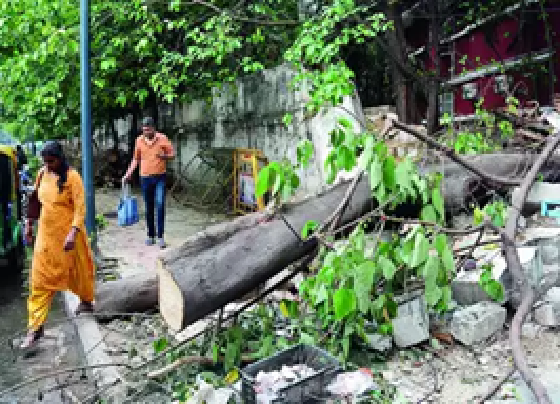
Unpaid fire watchers make vigil damp squib
Nischith N | NT
How motivated a worker will continue to be when something as basic as the salary is not paid is anyone’s guess. And, when the job of the worker is spotting a forest fire early and either dousing it or sounding an alert because of which the damage is minimised, the risk involved becomes that bigger. A number of such forest fire watchers who are hired on a daily-wage basis have complained that they have not been paid for five-six months. Nischith N notes the problem is deeper, as funds to be released by the Centre for the purpose have taken a long time in coming.
Due to the rising temperature owing to the present weather, the risk of fire in forests is increasing. One spark can quickly destroy several hectares of forest cover. In recent days, the State Forest Service cautioned the locals against venturing into forests during the hot weather, because the reckless behaviour of people is one of the main causes of fire in the highly vulnerable locale. And, such fires result in huge losses to the exchequer. A recent report revealed that 2,262 incidents of fire were recorded in the last two months.
According to reports, it is claimed that workers who patrol forests are finding it difficult to earn two square meals. Forest guards and fire watching by patrolling inside thick forests play a critical role in protecting tigers from poachers and also monitoring fire mishaps in Karnataka. However, a majority of them, who are employed on a daily-wage basis in crucial tiger reserves, have not been paid their salaries since the last four months. This is the main reason for fire accidents and environmentalists fear this could adversely affect conservation efforts well into the future.
“Daily-wage workers employed in wildlife sanctuaries such as MM Hills, Bhimgad, Pushpagiri, Talacauvery, Brahmagiri and Nagarahole have reportedly not been paid salaries for the last few months. With salaries paid to them once in five or six months, they find it extremely difficult to make ends meet, with a few even looking at alternative forms of livelihood,” a senior forest official told News Trail.
From the beginning of January till February, a total of 3,121 fire alerts have been received by the Forest department, while 2,262 fire incidents were reported across Karnataka. The data also shows that around 1,300 forest fire points have been sent to the state government by the department.
Every summer, all tiger reserves and other forest ranges hire 500-plus fire watchers to tackle forest fires in each of the protected areas, depending on the area, its sensitivity and beat size. Mostly youngsters from different tribal villages are selected and handpicked for the job. They are provided accommodation at anti-poaching camps, so that they can keep a close vigil to check any outbreak of fires.
Experts said the forest department carries out fireline exercise, which refers to cleaning up of around 30 metres of area around potential fire zones by clearing shrubs, bushes and deadwood.
Sridhar Punati, Former principal chief conservator of forests
As many as 99 per cent of forest fires are manmade! Mostly cattle grazers set fire to grass in the dry season as burnt grass gives fresh shoots after a few days. People collecting non-timber forest produce set fires to litter below trees from which fruits or seeds are to be collected. This spreads to other areas and burns an entire forest. Even honey collectors use fire to smoke away bees and collect honey, often causing forest fires.
People who smoke carelessly throw burning stubs on roadside hay, which catches fire. Some miscreants who are unhappy with strict forest officers deliberately go into the jungle and set fire in the hope that the officer is charged with dereliction of duty and disciplinary action initiated against them results in transfer. There are instances of local people disgruntled and vexed with frequent raids by wild elephants, tigers, leopards eating and damaging crops, cattle and pets who also go in and set fire. Instances of some disgruntled NGOs setting fire to forests to settle scores with forest officers have also come to the notice of the department.
The department has also got to know that some NGOs set fire and make huge negative propaganda and once the fire is doused, claim they mobilised people and get the fire under control and claim international funds.
What is surprising is that those local people involved in setting fire deliberately use data scientifically to set fire to forests. Major fires are set keeping in mind the intense heat, severe dryness, wind speed and direction. Further, on days of high suscept
 English daily published in Bengaluru & Doha
English daily published in Bengaluru & Doha






